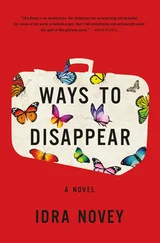I remain silent too, standing just inside the door. How different it would all be if it were Bernard who sat there, in the same posture and the same clothes, bent over the same sheet of paper. I’d walk over to him without speaking, take his head in my hands, turn his face up to mine. And then I’d do it again, the thing I mustn’t — I would — I’d kiss him.
He would laugh, speak, do something . And it would be something that had meaning, something that fit the occasion, that fit him in particular and me in particular — because he’s a real person and not just a diseased brain with a body attached.
Or no, no words. I would let him know that with just my eyes, and immediately he’d understand. And then he’d rise, and we’d press our bodies together, in a way I haven’t pressed my body against anyone’s in more than half a year.
He won’t get sick. He won’t call later and say that we can never see each other again. This time we can keep going. And we’ll unbutton each other’s pants right there on the desk that stands in front of me, there where my foolish, sick husband sits with nothing but speakers in his head.
I look at Frederik’s face. He’s gotten small pimples on the top of his forehead these past few months, and fat deposits on his cheeks; all that unhealthy food. What’ll he do if Emilie’s noisy when she comes? He must be just as starved for it as me. Will he try to go in there? Will he throw himself on me? Will he become aggressive and unbearable so that I have to hit him again?
“Come, we’re going for a walk,” I say.
He stares at me, only aware now that I’m in the room. “Now? It’s nighttime! We never go for walks at night.”
“No, but tonight we’re going to.”
“I’m sitting here in the middle of deciding whether—”
“It’ll have to wait for another time. Come. We’re going now.”
“Why?”
“We just are. Come.”
“But I don’t want to go for a walk.”
Since the operation, it’s been me who decides everything here at home. Which friends we’re going to call, and when; what we’re going to eat, and when; which websites we visit, and when. He grouses about it all the time, but he always does what I say anyway.
“Let’s go,” I say, pulling him out past Niklas’s room. I still don’t hear any sounds from in there. Downstairs, I throw Frederik his jacket, the lining the color I imagine Bernard’s pubic hair must be, and then I drag him out onto our small residential street, with the high hedges standing there so peaceful and lovely in the night. This is where we live.

Which Alcoholic Would You Prefer as a Son-in-Law?

TOM BUCHMANN
Our society risks becoming much more callous in its treatment of deviants.
Tom Buchmann has an MS in sociology and serves as a senior researcher at the Center for Future Studies.
IN 2009, AFTER IT WAS revealed that Tiger Woods had had at least 11 extramarital affairs, it didn’t take long for the golf star to be admitted to a rehabilitation facility for the treatment of sex addiction. Woods wasn’t a mendacious, egotistic person — no no, he was merely the victim of an illness.
After similarly embarrassing public episodes, other celebrities have explained that they too suffer from disorders, including various forms of dependency and the inability to control anger. We’re inclined to shrug off these statements with a quick laugh and not think any more about them, but in point of fact the celebrities are right. They haven’t wanted to take drugs, or to destroy their marriages and careers with angry outbursts. They’ve never consciously wished for lives like that.
In recent years, science has found genetic and neurological explanations for a host of human weaknesses, including:
• alcoholism and other forms of substance abuse
• lack of concentration
• poor social skills
• excessive fits of rage
• timidity
• self-centeredness
• loss of initiative
The latest research has shown that all of these character traits have a physiological basis — and that if it’s at all possible to change them, it isn’t simply by “pulling yourself together.”
As a result, we live in an era when our shared sense of what it means to be human and exercise responsibility has been changing at breakneck speed. The way we think about our impossible son (ADHD), our boozing uncle (addictive personality), and our killjoy mother (hidden depression) is shifting. Who are these people really? And how should we relate to them if they’re not to blame for their own actions?
IN THE COURSE OF the next few years, many other human traits will become closely associated with neurological functions and dysfunctions. This is something that can be stated with complete confidence, since it’s an unavoidable consequence of the huge breakthroughs in brain research.
If someone is lazy, for instance, soon we may be able to measure what it is in his or her brain that is causing the laziness. And perhaps all lazy people will be able to address this trait merely by taking a pill — just as we’ve seen with the tremendously widespread use of anti-anxiety drugs and antidepressants, and of concentration-enhancing drugs for children with ADHD.
The causes of numerous other personality traits will doubtless be determined in the same fashion; the only thing we don’t know is the exact order in which they’ll be identified. They may include the reasons for things like compulsive lying, pigheadedness, and poor long-term planning. And we’ll be able to address some of these traits pharmaceutically.
Accordingly, human personality will become something one can increasingly design and purchase. Certain coveted personality traits will require the newest, most advanced treatments — perhaps even surgical or electromagnetic intervention in the brain. In this way, these characteristics will become status symbols in the course of a couple of decades, just like costly cosmetic surgery has been in recent years.
This development isn’t an abstraction or something that belongs to the distant future. It’s already happening now, and in a few years it will pick up a great deal of speed. Consider for instance how rapidly the ways we think about depression, childhood hyperactivity, and male impotence have changed after having stood essentially still for millennia.
OF COURSE IT IS DIFFICULT, if not impossible, to predict how our culture will react to new knowledge about how we really function. But the following thought experiment may provide a clue.
Imagine that you know two men who both have serious drinking problems, and who both hit their wives and children when they are drunk. You find the way they treat their families deeply disturbing. Brain scans reveal that one of the men is neurologically normal. They also show that, neurologically, the second man is highly disposed to alcoholism and violence — and in fact, on the basis of his scans, the specialists expect him to behave at least as terribly as he does.
What is your attitude to each of these men? Would you be more forgiving of one than the other? Would you be able to be friends with one and not the other — and if so, which one? Take your time mulling it over, for the answers to these questions are far from straightforward.
Your reaction to the man who is neurologically normal is probably reminiscent of the way many people regarded violent alcoholics 20 years ago, when few people knew that alcoholism could be considered a disease. This man has made some despicable choices and quite likely attracts your greatest moral condemnation.
Читать дальше





![Ally Carter - [Gallagher Girls 01] I'd Tell You I Love You But Then I'd Have to Kill You](/books/262179/ally-carter-gallagher-girls-01-i-d-tell-you-i-lo-thumb.webp)








